Bioengineering Case Study: Riverdale Avenue Retaining Wall Replacement
January 31, 2018 |
One definition of bioengineering is the practice of incorporating natural materials into the design of engineered structures. The Riverdale Avenue Retaining Wall Replacement project is an innovative example of solving a riverbank slope stabilization problem with bioengineering.
One of the City of Calgary’s goals is to protect and restore riparian areas in its watersheds. From 2014 to 2017, Klohn Crippen Berger (KCB) worked with the City to replace a 245-m long creosote-treated timber retaining wall along the bank of the Elbow River. The retaining wall protects a busy pedestrian pathway, residential street and buried utilities from river erosion. In addition, the City wanted to restore the damaged riverbank habitat following the significant flood in 2013. KCB designed and monitored the construction of three bioengineering structures: wattle fences, live grating, and a vegetated “H-pile” wall (i.e. using piles in the shape of the letter “H”).
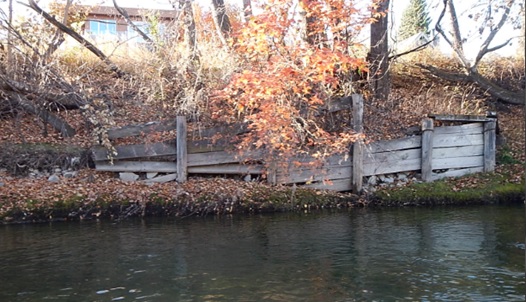
Wattle Fence
In 2015, KCB worked with Polster Environmental Services Ltd. and Year-Round Landscaping Ltd. to test a 25-m long wattle fence made entirely of willow and dogwood cuttings. The wall was built by pounding vertical cuttings into the ground, layering horizontal cuttings behind the vertical posts, and backfilling it with a mix of native riverbank soils and gravel to create a series of small terraces up the slope.
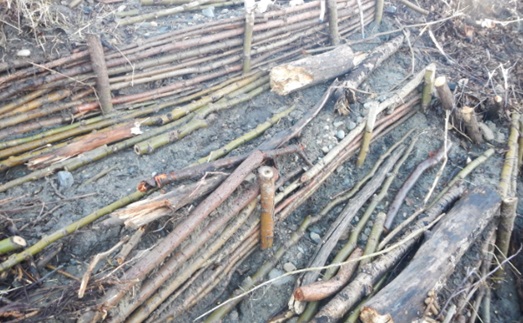
We learned that:
-
- the addition of gravel to the backfill made it too free-draining, causing the soil to become very dry;
- the dogwood cuttings were too small to successfully establish new growth;
- the horizontal cuttings quickly dried out because they were exposed to Calgary’s dry summer, impacting their effectiveness in stabilizing the slope;
- the cuttings were not able to establish and stabilize the bottom of the riverbank quickly enough, which resulted in undercutting below the wattle fence.
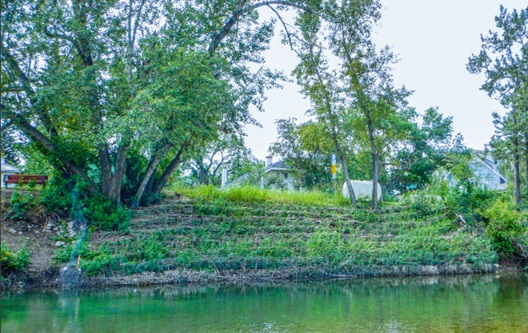
Live Grating
Based on the lessons learned from the wattle fence, KCB and Terra Erosion Control Ltd. (TEC) designed a ‘Live Grating’ 1.5H:1V slope stabilization structure made from a grid of untreated logs, planted with willow cuttings, native trees and shrubs in the grid spaces. Riprap was placed from the toe of the slope up to the top of the bank to protect the Live Grating from undercutting by the river, while minimizing the riprap's impact on fish habitat and the river’s hydraulic capacity. For this project, KCB compared the modelled shear forces along the river bank with the available technical data for vegetation resistance. We found that once established, the trees, shrubs and grasses enhance slope stability and have sufficient shear resistance to reduce the potential for erosion during a flood.
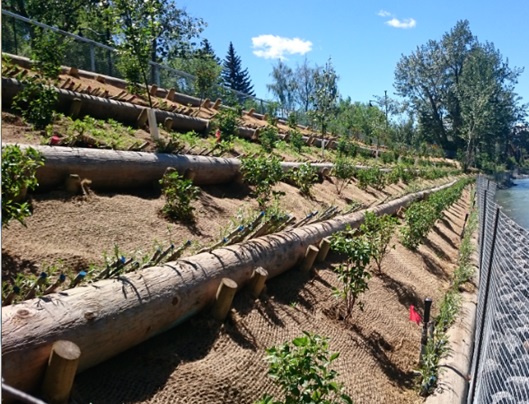
In the fall of 2016, Slimdor Contracting Ltd. built the Live Grating log frame by incorporating the test wattle fence. They subsequently planted potted trees and shrubs in the spring of 2017. Over 3,500 willow cuttings were installed and over 300 trees and shrubs were placed in the individual grid spaces. Each grid space was then seeded with a native grass seed mix and protected with an anchored coir (coconut fibre) wrap erosion control blanket.
During the first growing season, Slimdor Contracting maintained the plantings by watering them frequently, removing weeds and installing protective fences to deter beavers and muskrats. After the first growing season, the willow cuttings grew up to 2.0 m tall and the shrubs and trees started to flourish. Monitoring and maintenance of a site over the first couple of years following construction is key to the success of a bioengineering project.
Vegetated H-pile Wall
Due to limited space at the top of the slope, we determined that a vertical retaining wall was required to stabilize the slope and minimize the disturbance of creosote-contaminated soils. An H-pile wall with reinforced concrete panels and a vegetated riprap toe were designed to meet the engineering requirements. We worked with TEC to design ‘windows’ in the concrete structural panels for planting native shrubs. The approximately 460 native shrubs will eventually establish a dense root network and grow to fill the windows.
To make the new retaining wall look more natural than plain concrete, local artist Peter von Tiesenhausen was commissioned to design a natural façade consisting of cobbles, gravel and sand. On the façade, he created ledges for nesting swallows and developed new bee habitats using dried vegetation embedded in the concrete panels.
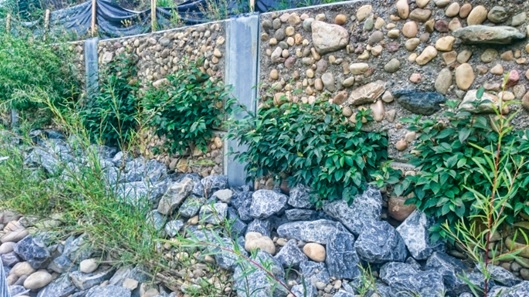
As part of the design team, KCB designed and built three pioneering bioengineering techniques for stabilizing a section of the Elbow River bank at Riverdale Avenue in the City of Calgary. These three techniques will continue to be monitored for vegetation establishment over the upcoming years so that they can be refined and modified as necessary. These techniques have application for other riverbank stabilization projects across Canada and elsewhere.
For further information about this project and how we can help you include bioengineering in your projects, please contact us at info@klohn.com or call our Calgary office at 1-403-274-3424.
